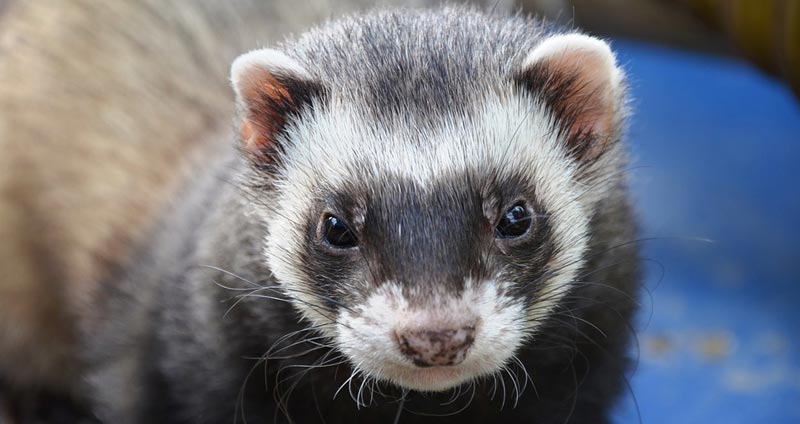If you own a hairy or furry pet such as a ferret, knowing how to best care for that fur is an essential part of your job as the owner. Having this knowledge will help you keep your ferret happy and healthy throughout their life. Additionally, it will help you to identify any irregularities that need to be quickly dealt with.
When it comes to a ferret’s coat, a lot of people aren’t sure whether or not these creatures shed. This post will cover all that you need to know about your carpet shark’s hair loss.
Table of Contents
Do Ferrets Shed?
Yes, ferrets do shed — much like many other domestic creatures. Ferrets primarily experience periods of shedding or molting throughout the year depending on the season. However, they can also shed as a result of several other factors that you should be aware of.
Most ferrets will only experience seasonal molting, which is entirely normal. However, if you experience your ferret excessively shedding outside of these times, it may be indicative of a serious problem with your ferret’s health.
Knowing what the other causes of hair loss in ferrets are will make it easy for you to identify health problems and quickly remedy them.
Types Of Hair Loss In Ferrets
As stated, there are several different types of hair loss in ferrets. Some shedding is entirely natural and can’t be avoided, while other shedding can be prevented with proper medical care. Most ferrets that are properly cared for will never experience the other negative types of shedding, so don’t stress out too much!
Seasonal Molting
Ferrets are very photosensitive, so changes in daylight hours have a large impact on ferrets. One of the biggest impacts of changing daylight hours is seasonal molting in ferrets — something that happens twice a year. Every spring, a ferret sheds the entirety of its heavy winter coat in exchange for a lighter and sleeker coat. Then, when fall approaches, the ferret sheds it light coat for a warm winter one.
This shedding is typically very gradual, so your ferret won’t experience massive amounts of hair loss. However, some ferrets can shed their winter coat in spring in an extremely short amount of time, often resulting in a sparse coat for several days.
Some ferrets may also have a patchy appearance due to their guard hairs shedding before their undercoat. This is also very normal and will quickly balance back out within a few days.
During this period of molting, it’s recommended that you brush your ferret to help them along with their transformation. Using a soft brush with thick bristles, brush against the grain and with a slight turn of the wrist to help dislodge any loose hair. This will help the shed go more smoothly and keep your ferret comfortable during this time.
Improper Care
If you see your ferret losing hair and it’s not time for their bi-yearly shed, there’s a good chance it’s because of improper care on your end. Specifically, a poor diet is a common cause of unintended hair loss in ferrets.
Ferrets need to eat specific food that meets their dietary requirements. This includes about 35% animal protein and between 15% and 20% fat. If a ferret doesn’t get this nutrition from their food, they’ll become malnourished and will likely lose a good amount of their fur. Fortunately, it isn’t hard to find a food that meets these requirements, as even some cat food works well for ferrets.
Hair loss may also occur if the ferret isn’t getting enough sleep. These creatures are crepuscular, so they’re active from dusk until dawn. During its long sleeping periods, ferrets need darkness and a quiet environment in order to get healthy sleep and absorb the necessary melatonin.
Adrenal Gland Disease
This is another extremely common cause for hair loss, and all types of ferrets are susceptible to this disease. Adrenal gland disease is a result of aging in ferrets, and it causes adrenal glands to become overactive and produce sex hormones that result in hair loss. The most common hair loss pattern starts from the tail and moves upward towards the head.
Fortunately, it’s very easy to diagnose this disease through either a physical examination or bloodwork. It can be treated through either medication or surgery, and your vet will determine the best course of action.
Tail Alopecia (Rat Tail)
Hair loss that’s mostly present in male ferrets around mating season in the summer. While it’s most common in unfixed ferrets, it can still occur in ferrets that have been spayed or neutered.
This condition results in a ferret losing most or all of the hair on their tail, resulting in something that looks like a rat’s tail. The hair loss is accompanied by scaly skin and very sparse and bristly hair. Fortunately, after a ferret goes through its normal shed, the tail hair tends to come back.
It’s commonly thought that tail alopecia can be a predecessor to adrenal gland disease. Therefore, if your ferret experiences hair loss in their tail, you should take them to a veterinarian to get tested and potentially treated.
Parasites
A more unnatural cause for hair loss is through parasites. Ferrets that are exposed to the outdoors can potentially pick up fleas and various different kinds of mites. These ailments don’t cause hair loss directly, but they result in a lot of scratching of the affected areas that will result in hair loss.
Fleas usually take residence around the neck and shoulder area of a ferret, and mites commonly take to a ferret’s ears. Treating these pests is simple, though, as a topical product applied regularly usually gets rid of them.

